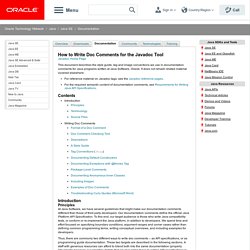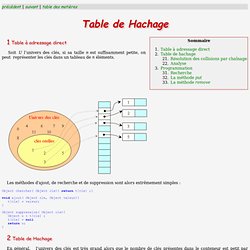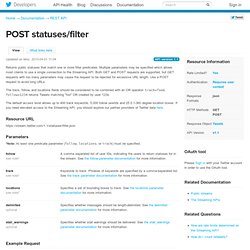

WAR Deployment. Méthodologie. How to Write Doc Comments for the Javadoc Tool. Javadoc Home Page This document describes the style guide, tag and image conventions we use in documentation comments for Java programs written at Java Software, Oracle.

It does not rehash related material covered elsewhere: Les Expressions Languages. Les Expressions Languages ( EL ) permettent de manipuler les données au sein d'une page JSP (ou d'un fichier *.tag) plus simplement qu'avec les scriptlets Java.

Une EL permet d'accéder simplement aux beans des différents scopes de l'application web ( page , request , session et application ). Utilisé conjointement avec des librairies de tags, elles permettent de se passer totalement des scriptlets. Une expression EL est de la forme suivante : La chaîne expression correspond à l'expression à interpréter. Une expression peut être composée de plusieurs termes séparés par des opérateurs (Voir " Les opérateurs ") : $ { terme1 opérateur terme2 } $ { opérateur - unaire terme } $ { terme1 opérateur terme2 opérateur terme3 [opérateur terme * ]... } etc.
Regexp. Introduction Une expression régulière est une chaîne de caractères (c'est-à-dire une succession de caractères) spéciale dont l'interprétation décrit un ensemble de chaînes composées de caractères habituels.

Elle correspond donc à un patron de chaînes de caractères ou de formes, de valeurs de propriétés, etc. Par exemple, l'expression régulière é.* peut décrire l'ensemble de toutes les formes d'un vocabulaire commençant par le caractère " é ". Arbres. Précédent | suivant | table des matières.

Conteneurs : Table de hachage. Précédent | suivant | table des matières 1 Table à adressage direct Soit U l’univers des clés, si sa taille n est suffisamment petite, on peut représenter les clés dans un tableau de n éléments.

Les méthodes d'ajout, de recherche et de suppression sont alors extrêmement simples : Object chercher( Object cle){ return t[cle] ;} void ajout( Object cle, Object valeur){ t[cle] = valeur; } API tweeter POST statuses/filter. Returns public statuses that match one or more filter predicates.

Multiple parameters may be specified which allows most clients to use a single connection to the Streaming API. Both GET and POST requests are supported, but GET requests with too many parameters may cause the request to be rejected for excessive URL length. Use a POST request to avoid long URLs. The track, follow, and locations fields should be considered to be combined with an OR operator. track=foo&follow=1234 returns Tweets matching "foo" OR created by user 1234. The default access level allows up to 400 track keywords, 5,000 follow userids and 25 0.1-360 degree location boxes.
Resource URL. Implementing Sign in with Twitter. Overview.

HIBERNATE. Spring. MySQL. Apache Tomcat 7 (7.0.22) - Documentation Index. JUnit Cookbook. Kent Beck, Erich Gamma Here is a short cookbook showing you the steps you can follow in writing and organizing your own tests using JUnit.

Simple Test Case How do you write testing code? JUnit: A Cook’s Tour. Note: this article is based on JUnit 3.8.x. 1.

Introduction In an earlier article (see Test Infected: Programmers Love Writing Tests, Java Report, July 1998, Volume 3, Number 7), we described how to use a simple framework to write repeatable tests. JUnit. JUnit a été initialement développé par Erich Gamma et Kent Beck.

JUnit propose : Un framework pour le développement des tests unitaires reposant sur des assertions qui testent les résultats attendus Des applications pour permettre l'exécution des tests et afficher les résultats. Java Platform Standard Edition 7 Documentation. API - Java SE 7. How to Write an Action Listener (The Java™ Tutorials > Creating a GUI With JFC/Swing > Writing Event Listeners) Action listeners are probably the easiest — and most common — event handlers to implement. You implement an action listener to define what should be done when an user performs certain operation. An action event occurs, whenever an action is performed by the user. Examples: When the user clicks a button, chooses a menu item, presses Enter in a text field. Développons en java. - The Java EE 6 Tutorial. API - Java EE 6. File Download In Spring. In order to implement a file download in Spring, the key is returning null instead of a ModelAndView object.
This controller that I created below is specifically for text/ascii data. You'd need to change the content type appropriately in order to download other file types. public class DownloadController implements Controller { /* * Spring dependency injection */ private XService xService; public void setxService( XService xService) { this.xService = xService; } public ModelAndView handleRequest(HttpServletRequest request, HttpServletResponse response) throws Exception { String idStr = request.getParameter("id"); if (idStr ! Private void doDownload(HttpServletRequest request, HttpServletResponse response, String data, String filename) throws IOException { int length = data.length(); ServletOutputStream op = response.getOutputStream();
JDBC Overview. Contents. Creating and Configuring Servlets. This script outputs the banner required for edocs documentation. This script outputs the google search parameters required for search on edocs documentation. The following sections describe how to create and configure servlets. Configuring Servlets With Java EE metadata annotations, the standard web.xml deployment descriptor is now optional. The Servlet 2.5 specification, states annotations can be defined on certain web components, such as servlets, filters, listeners, and tag handlers.
Overview of Interceptors - The Java EE 6 Tutorial. Interceptors are used in conjunction with Java EE managed classes to allow developers to invoke interceptor methods on an associated target class, in conjunction with method invocations or lifecycle events. Common uses of interceptors are logging, auditing, and profiling.